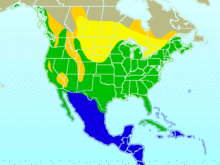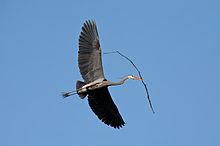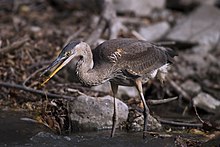There is a tree full of birds just west of Kamloops and I have been trying to get a picture of them and an idea of what they are. Finally this morning.....and realized that they are.....
Great Blue Heron
From Wikipedia, the free encyclopedia
This article is about the bird. For the Music Festival, see The Great Blue Heron Music Festival.
| Great Blue Heron | |
|---|---|
 |
|
| Great Blue Heron in St. Joseph Sound, Tarpon Springs, FL. | |
| Conservation status | |
| Scientific classification | |
| Kingdom: | Animalia |
| Phylum: | Chordata |
| Class: | Aves |
| Order: | Pelecaniformes |
| Family: | Ardeidae |
| Genus: | Ardea |
| Species: | A. herodias |
| Binomial name | |
| Ardea herodias Linnaeus, 1758 |
|
 |
|
| Yellow: breeding; green: year-round: blue:winter | |
Taxonomy
The Great Blue Heron was one of the many species originally described by Carolus Linnaeus in his 18th century work, Systema Naturae.[2]The Great Blue Heron is replaced in the Old World by the very similar Grey Heron, which differs in being somewhat smaller (90–98 cm), with a pale gray neck and legs, lacking the browner colors that Great Blue Heron has there. It forms a superspecies with this and also with the Cocoi Heron from South America, which differs in having more extensive black on the head, and a white breast and neck.
There are five subspecies:[3]
- Ardea herodias herodias Linnaeus, 1758. Most of North America, except as below.
- Ardea herodias fannini Chapman, 1901. The Pacific Northwest from southern Alaska south to Washington; coastal.
- Ardea herodias wardi Ridgway, 1882. Kansas and Oklahoma to northern Florida. Sightings in southeastern Georgia have occurred.
- Ardea herodias occidentalis Audubon, 1835. Southern Florida, Caribbean islands. Formerly known as a separate species, the Great White Heron.
- Ardea herodias cognata Bangs, 1903. Galápagos Islands.
Description
It is the largest North American heron and, among all extant herons, it is surpassed only by the Goliath Heron and the White-bellied Heron. It has head-to-tail length of 91–137 cm (36–54 in), a wingspan of 167–201 cm (66–79 in), a height of 115–138 cm (45–54 in), and a weight of 2.1–3.6 kg (4.6–7.9 lb).[4][5][6] Notable features include slaty flight feathers, red-brown thighs, and a paired red-brown and black stripe up the flanks; the neck is rusty-gray, with black and white streaking down the front; the head is paler, with a nearly white face, and a pair of black plumes running from just above the eye to the back of the head. The feathers on the lower neck are long and plume-like; it also has plumes on the lower back at the start of the breeding season. The bill is dull yellowish, becoming orange briefly at the start of the breeding season, and the lower legs gray, also becoming orangey at the start of the breeding season. Immature birds are duller in color, with a dull blackish-gray crown, and the flank pattern only weakly defined; they have no plumes, and the bill is dull gray-yellow.[3][7][8] Among standard measurements, the wing chord is 43–49.2 cm (17–19.4 in), the tail is 15.2–19.5 cm (6.0–7.7 in), the culmen is 12.3–15.2 cm (4.8–6.0 in) and the tarsus is 15.7–21 cm (6.2–8.3 in).[9][10]The heron stride is around 22 cm (9 in), almost in a straight line. Two of the three front toes are generally closer together. In a track the front toes as well as the back often show the small talons.[11]
The subspecies differ only slightly in size and plumage tone, with the exception of subspecies occidentalis, which as well as normal colored birds, also has a distinct white morph, known as the Great White Heron (not to be confused with the Great Egret, for which "Great White Heron" was once a common name). It is found only in south Florida and some parts of the Caribbean. The Great White Heron differs from other Great Blues in bill morphology, head plume length, and in having a total lack of pigment in its plumage. This is mainly found near salt water, and was long thought to be a separate species. Birds intermediate between the normal morph and the white morph are known as Würdemann's Heron; these birds resemble a "normal" Great Blue with a white head.
The theory that Great White Heron may be a separate species (A. occidentalis) from Great Blue Heron has again been given some support by David Sibley.[12]
Voice
The call is a harsh croak. The heron is most vocal during the breeding season, but will call occasionally at any time of the year in territorial disputes or if disturbed. |
|
| Problems listening to this file? See media help. | |
Similar species
The "Great White Heron" could be confused with Great Egret but is larger, with yellow legs as opposed to the Great Egret's black legs. The Reddish Egret and Little Blue Heron could be mistaken for the Great Blue Heron, but are much smaller, and lack white on the head and yellow in the bill. In the southern reaches of its range, the Great Blue sometimes overlaps in range with the closely related and similarly sized Cocoi Heron. The Cocoi is distinguished by a striking white neck and solid black crown, but the duller juveniles are more easily confused. More superficially similar is the slightly smaller Grey Heron, which may sometimes vagrate to the Northern coasts of North America. The Grey (which occupies the same ecological niche in Eurasia as the Great Blue Heron) has very similar plumage but has a solidly soft-gray neck. Erroneously, the Great Blue Heron is sometimes referred to as a "crane".Distribution and habitat
The Great Blue Heron can adapt to almost any wetland habitat in its range. They may be found in numbers in fresh and saltwater marshes, mangrove swamps, flooded meadows, lake edges, or shorelines. They are quite adaptable and may be seen in heavily developed areas as long as they hold bodies of water bearing fish. Great Blue Herons rarely venture far from bodies of water but are occasionally seen flying over upland areas. They usually nesting in trees or bushes near water's edge, often on island (which minimizes the potential for predation) or partially isolated spots.[13]
It has been recorded as a vagrant in England,[14] Greenland, Hawaii, and the Azores.[3]
Behavior
Diet
The primary food for Great Blue Heron is small fish, though it is also known to opportunistically feed on a wide range of shrimp, crabs, aquatic insects, rodents and other small mammals, amphibians, reptiles, and small birds. Herons locate their food by sight and usually swallow it whole. Herons have been known to choke on prey that is too large.[15] It is generally a solitary feeder. Individuals usually forage while standing in water, but will also feed in fields or drop from the air, or a perch, into water. mice are occasionally predated in upland areas far from the species typical aquatic environment.[13] Occasionally loose feeding flocks may form and may be beneficial since they are able to locate school of fish more easily.[13] As large wading birds, Great Blue Herons are capable of feeding in deeper waters, and thus are able to harvest from niche areas not open to most other heron species.Typically, the Great Blue Heron feeds in shallow waters, usually less than 50 cm (20 in) deep,[13] or at the water's edge during both the night and the day, but especially around dawn and dusk. The most commonly employed hunting technique of the species is that it wades slowly with its long legs through shallow water, and quickly spears fish or frogs with its long, sharp bill. Although usually ponderous in movements, the Great Blue Heron is surprisingly adaptable in its fishing methods. Feeding behaviors variably have consisted of standing in one place, probing, pecking, walking at slow speeds, moving quickly, flying short distances and alighting, hovering over water and picking up prey, diving headfirst into the water, alighting on water feet-first, jumping from perches feet-first, and swimming or floating on the surface of the water.[13]
Breeding
This species usually breeds in colonies, in trees close to lakes or other wetlands. Often such colonies include only Great Blue Herons, sometimes they nest alongside other species of herons. These groups are called heronry (a more specific term than "rookery"). The size of these colonies may be large, ranging between 5–500 nests per colony, with an average of approximately 160 nests per colony. Heronry are usually relatively close, usually within 4 to 5 km (2.5 to 3.1 mi), to ideal feeding spots.[13]Great Blue Herons build a bulky stick nest, and the female lays three to six pale blue eggs. One brood is raised each year. If the nest is abandoned or destroyed, the female may lay a replacement clutch. Reproduction is negatively affected by human disturbance, particularly during the beginning of nesting. Repeated human intrusion into nesting areas often results in nest failure, with abandonment of eggs or chicks.
Both parents feed the young at the nest by regurgitating food. Parent birds have been shown to consume up to four times as much food when they are feeding young chicks than when laying or incubating eggs.
Eggs are incubated for around 28 days[16] and hatch asynchronously over a period of several days. The first chick to hatch usually becomes more experienced in food handling and aggressive interactions with siblings, and so often grows more quickly than the other chicks. Predators of eggs and nestlings include turkey vultures, several corvids, hawks, bears and raccoons, the latter two also potential predators of adults. Adult herons, due to their size, have few natural predators, but can be taken by Bald Eagles, Golden Eagles and, less frequently, Great Horned Owls and Red-tailed Hawks. When predation on an adult or chick occurs at a breeding colony, the colony can be abandoned by the other birds, but this does not always occur.[17]
In art
John James Audubon illustrates the Great Blue Heron in Birds of America, Second Edition (published, London 1827–38) as Plate 161. The image was engraved and colored by Robert Havell's, London workshops. The original watercolor by Audubon was purchased by the New-York Historical Society where it remains to this day (January 2009).I am doing my servicing today...washed the truck, got an oil change, doing a laundry...
And I am getting a CD error on my in-dash player. I have found some info on fixing it...hahahah..yeah, right...me fix it...but I am going to give it a try. I was going to just buy a new one, so nothing to loose.
If you wanted to try and fix yours.....
http://www.kuro5hin.org/story/2004/3/24/45212/6874















No comments:
Post a Comment